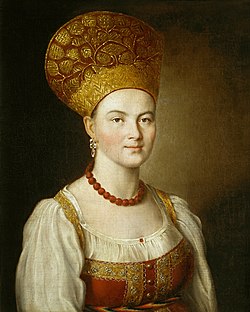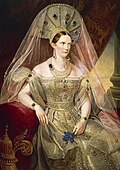Kokoshnik

Thekokoshnik(Russian:коко́шник,IPA:[kɐˈkoʂnʲɪk]) is atraditionalRussianheaddress worn by women and girls to accompany thesarafan.The kokoshnik tradition has existed since the 10th century in the city ofVeliky Novgorod.[1]It spread primarily in the northern regions of Russia and was very popular from 16th to 19th centuries. It is still to this day an important feature of Russian dance ensembles and folk culture and inspired theKokoshnik style of architecture.
Overview[edit]
Historically a kokoshnik[2]is a headdress worn by married women, though maidens also wore a headdress very similar to a kokoshnik, but open in the back, named apovyazka.[3]The wordkokoshnikdescribes a great variety of headdresses worn throughout Russia, including the cylindrical hats ofVeliky Novgorod,two-pointed nimbuskikaof Vladimir, triangularkikaofKostroma,small pearl hats ofKargopol,and scarlet kokoshniks ofMoscow.
While in the past kokoshnik styles varied greatly, currently a kokoshnik is generally associated with a tall, nimbus or crest shaped headdress which is tied at the back of the head with long thick ribbons in a large bow. The crest can be embroidered with pearls andgoldworkor simple applique, usually using plant and flower motifs. The forehead area is frequently decorated with pearl netting. While wearing a kokoshnik the woman usually wears her hair in aplait.The kokoshnik were often also combined with theRussian braid.
History[edit]

The wordkokoshnikfirst appears in 16th-century documents, and comes from theOld Slavickokosh,which means"hen"or "cockerel".However, the earliest head-dress pieces of similar type (rigid cylindrical hat which completely covered the hair) were found in the 10th- to 12th-century burials inVeliky Novgorod.[4]
Thekokoshnikgave its name to the decorativecorbelarch that became a distinctive element of traditionalRussian architecturefrom the 16th century onwards (seekokoshnik architecture).
During the revival of Russian national culture in the early 19th century, diadem-shapedtiarasbecame part of the officialcourt dressfor royalty and for ladies-in-waiting. These "kokoshniks" were inspired just as much by Italian Renaissance fashions and by thefrench hoodas by the authentic Russian kokoshniks still worn by the middle class and wealthy peasants of the time. In this period both unmarried and married women wore the variety used traditionally by unmarried women: showing the front part of the hair, and with a translucent veil falling down the back.
After the1917 Revolution,Russianémigréspopularized the kokoshnik within Europeanfashion.The style had previously appeared in the 1893 wedding headdress ofMary of Teck,the futureQueen consort of the United Kingdom.
Queen Marie of Romaniawore aCartiertiara created to resemble the Russian kokoshnik for her 1924 portrait painted byPhilip de László.[5]The tiara was among the jewels on display in the "Cartier: Style and History" exhibition at theGrand Palaisin Paris from December 4 through February 16, 2014.[6]
One of the costumes of SenatorPadmé Amidalain theStar Warssaga, theGold Travel Costume,was based on the Russian national costume with kokoshnik,[7]known in the rest of Europe from the photographs taken during the1903 Ball in the Winter Palace.
Some fans of Russia at the2018 FIFA World Cupwore simple versions of kokoshniki.[8]In recent years[timeframe?]kokoshniki made out of flowers have become popular.[9]Kokoshniki are a popular Russian souvenir.[10]
Gallery[edit]
-
Seven different types of kokoshnik
-
A youngGrand Duchess Alexandra Pavlovnain kokoshnik andsarafan,1790s.
-
EmpressAlexandra Feodorovna (Charlotte of Prussia)in kokoshnik, 19th century.
-
A girl in kokoshnikbyMikhail Nesterov,1885.
-
BoyaryshnyabyViktor Vasnetsov(the portrait of V. S. Mamontova), 1884.
-
Boyaryshnyawith kokoshnik covered with veil. 19th-century painting byKonstantin Makovsky.
-
Russian girl with kokoshnik, before 1915, byKonstantin Makovsky
-
A woman wearing a large, rich, two-horned kokoshnik. 20th century. Photograph.
-
Princess Olga K. Orlova in Masquerade Costume for theBall of 1903.Photograph byElena Mrozovskaya.
-
Grand Duchess Olga Nikolaevna of Russiain Russian court dress in 1910
-
Girl in the KokoshnikbySophia Ivanovna Kramskaya
-
Women of Russian dance ensemble with kokoshniks in 2017
-
Illustration byBoris Zvorykin,in which appear three women, two of them wearing kokoshniks
See also[edit]
Similar headgear in other cultures[edit]
- Ochipok,Ukrainian
- Fontange
- Fengguan,Chinese
- French hood
- Gable hood
- Liangbatou,Chinese
References[edit]
- ^"Kokoshnik- The main part of the traditional Russian national costume".Experience Russia Blog.26 April 2019.Retrieved2019-06-05.
- ^"But Russian Kokoshnik at STPgoods store".STPgoods.com.Retrieved2019-07-09.
- ^Kirichenko, Evgenii︠a︡ Ivanovna (1991).The Russian Style.London: Laurence King. p. 51.ISBN9781856690041.
- ^Primeval Rus': Women's head dress and jewellery(in Russian)
- ^"Obiectul Lunii Ianuarie 2014 – Portretul Reginei Maria - Muzeul National Peles".Archived fromthe originalon 17 August 2014.
- ^Queen Marie of Romania portrait
- ^"The Padawan's Guide".www.padawansguide.com.
- ^"At World Cup, foreign fans adopted traditional Russian headdress".www.reuters.com/article/us-soccer-worldcup-kokoshnik/at-world-cup-foreign-fans-adopt-traditional-russian-headdress-idUSKBN1JX0PD.7 July 2018.
- ^Фото с кокошниками из цветов — Крокус(in Russian).Retrieved2019-06-11.
- ^"Souvenirs".Russian Support Visa(in Italian). Archived fromthe originalon 2018-10-09.Retrieved2019-06-11.
External links[edit]
- Кокошник (головной убор)in theGreat Soviet Encyclopedia,1969–1978 (in Russian)













